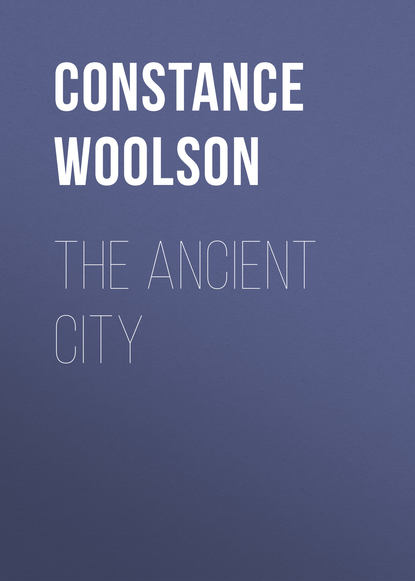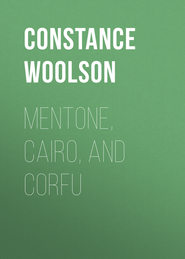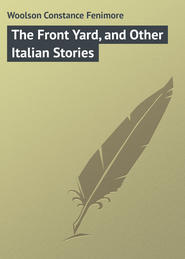По всем вопросам обращайтесь на: info@litportal.ru
(©) 2003-2024.
✖
The Ancient City
Настройки чтения
Размер шрифта
Высота строк
Поля
Her dug-out launches,
And down the stream to catch some crabs she takes her way,
A Spanish maiden,
With crabs well laden;
When evening falls she lifts her trawls to cross the bay.
“Grim terror blanches
Maria Sanchez,
Who, not to put too fine a point, is rather brown;
A norther coming,
Already humming,
Doth bear away that Spanish mai – den far from town.
“Maria Sanchez,
Caught in the branches
That sweetly droop across a creek far down the coast,
That calm spectator,
The alligator,
Doth spy, then wait to call his mate, who rules the roast.
“She comes and craunches
Maria Sanchez,
While boat and crabs the gentle husband meekly chews.
How could they eat her,
That señorita,
Whose story still doth make quite ill the Spanish Muse?”
We heaped praises upon John’s pure Castilian ode – all save the Professor, who undertook to criticise a little. “I have made something of a study of poetry,” he began, “and I have noticed that much depends upon the selection of choice terms. For instance, in the first verse you make use of the local word ‘dug-out.’ Now in my opinion, ‘craft’ or ‘canoe’ would be better. You begin, if I remember correctly, in this way:
“ ‘Maria Sanchez
Launches her dug-out – ’ ”
“Oh no, Professor,” said Sara; “this is it:
“ ‘Maria Sanchez
Her dug-out launches.’ ”
“The same idea, I opine, Miss St. John,” said the Professor, loftily.
“But the rhymes, Sir?”
The Professor had not noticed the rhymes; poetry should be above rhymes altogether, in his opinion.
The pleasant days passed, we sailed up and down the Matanzas, walked on the sea-wall, and sat in the little overhanging balcony, which, like all others in St. Augustine, was hung up on the side of the house like a cupboard without any support from below. Letters from home meanwhile brought tidings of snow and ice and storm, disasters by land and by sea. A lady friend, a new arrival, had visited the Ancient City forty years before, in the days of the ancien régime. “It is much changed,” she said. “These modern houses springing up every where have altered the whole aspect of the town. I am glad I came back while there is still something left of the old time. Another five years and the last old wall will be torn down for a horrible paling fence. Forty years ago the town was largely Spanish or Moorish in its architecture. The houses were all built of coquina, with a blank wall toward the north, galleries running around a court-yard behind, where were flowers, vines, and a central fountain. The halls, with their stone arches, opened out into this greenery without doors of any kind, tropical fashion. Those were the proud days of St. Augustine; the old families reigned with undisputed sway; the slaves were well treated, hospitality was boundless, and the intermixture of Spanish and Italian blood showed itself in the dark eyes that glanced over the balconies as the stranger passed below. It has all vanished now. The war effaced the last fading hue of the traditional grandeur, and broke down the barriers between the haughty little city and the outside world. The old houses have been modernized, and many of them have given place to new and, to my ideas, thoroughly commonplace dwellings. There is one left, however, the very mansion where I was so charmingly entertained forty years ago; its open arches remain just as they were, and the old wall still surrounds the garden. Up stairs is the large parlor where we had our gay little parties, with wines, and those delicious curled-up cakes, all stamped with figures, thin as a wafer, crisp and brittle, which seemed to be peculiar to St. Augustine.”
“Did you know there was a native artist here?” said John, calling up one morning as he sat on the balcony, Sara and myself endeavoring to write duty letters.
“Painter or sculptor?” I inquired, pen in hand, pausing over an elaborate description of a sunset with which I was favoring a soul-to-soul correspondent. “Let me see: standing on the glacis with the look-out tower outlined against – ”
“Sculptor,” answered John. “His studio is on Charlotte Street not far from here. Let us walk down and see him.”
“Look-out tower outlined against the golden after-glow. Is it worth going to see?”
“Indeed it is. There is a fine design – a lion carved in stone, and also a full-length figure of Henry Clay walking in the gardens of Ashland; and what is more, these statues are on top of the house outlined against – ”
“The golden after-glow,” I suggested.
“Certainly,” said John. “And inside you will find rare antique vases, Egyptian crocodiles, Grecian caskets, and other remarkable works, all executed in stone.”
“I have long craved an alligator, but could not undertake the cigar-box discipline,” I answered, rising. “A crocodile carved in stone will be just the thing. Come, Sara.”
We walked down Charlotte Street, and presently came to a small house with a low wing, whose open shutter showed the studio within. On the roof were two figures in coquina, one a nondescript animal like the cattle of a Noah’s ark, the other a little stone man who seemed to have been so dwarfed by the weight of his hat that he never smiled again.
“The lion, and Henry Clay,” said John, introducing the figures.
“Passé for the lion; but how do you make out the other?”
“Oh, Henry seems to be the beau ideal of the South. You meet him every where on the way down in a plaster and marble dress-coat, extending his hand in a conversational manner, and so, of course, I supposed this to be another one. And as to the gardens of Ashland, as he has his hat on – indeed, he is principally hat – he must be taking a walk somewhere, and where so likely as his own bucolic garden?”
“I shall go back to my after-glow, Mr. Hoffman. Your Henry Clay is a fraud.”
“Wait and see the artist, Martha,” said Sara. “He is a colored man and a cripple.”
We tapped on the shutter, and the artist appeared, supporting himself on crutches; a young negro, with a cheerful shining countenance, and an evident pride in the specimens of his skill scattered about the floorless studio – alligators, boxes, roughly cut vases, all made of the native coquina; or, as the artist’s sign had it,
“It must require no small amount of skill to cut any thing out of this crumbling shell-rock,” I said, as, after purchasing a charming little alligator, and conversing some time with the dusky artist, we turned homeward.
“It does,” replied John. “Ignorant as he is, that man is not without his ideas of beauty and symmetry – another witness to the capability for education which I have every where noticed among the freedmen of the South.”
“I too have been impressed with this capability,” said Sara – “strongly impressed. Last Sunday I went to the Methodist colored Sunday-school on St. George Street. The teachers are Northerners; some resident here, some winter visitors; and the classes were filled up with full-grown men and women, some of them aged and gray-haired, old uncles and aunties, eager to learn, although they could scarcely see with their old eyes. They repeated Bible texts in chorus, and then they began to read. It was a pathetic sight to see the old men slowly following the simple words with intense eagerness, keeping the place under each one with careful finger. The younger men and girls read fluently, and showed quick understanding in the answers given to the teachers’ questions. Then the little children filed in from another room, and they all began to sing. Oh, how they sang! The tenor voice of a young jet-black negro who sat near me haunts me still with its sweet cadences. Singularly enough, the favorite hymn seemed to be one whose chorus, repeated again and again, ended in the words,
“ ‘Shall wash me white as snow —
White as snow.’ ”
“The negroes of St. Augustine were formerly almost all Romanists,” said John, “and many of them still attend the old cathedral on the Plaza, where there is a gallery especially for them. But of late the number of Methodists and Baptists has largely increased, while the old cathedral and its bishop, who once ruled supreme over the consciences of the whole population of la siempre fiel Ciudad de San Augustin, find themselves in danger of being left stranded high and dry as the tide of progress and education sweeps by without a glance. The Peabody Educational Fund supports almost entirely two excellent free schools here, one for white and one for colored children; and in spite of opposition, gradually, year by year, even Roman Catholic parents yield to the superior advantages offered to their children, and the church schools hold fewer and fewer scholars, especially among the boys. The Presbyterian church, with its pastor and earnest working congregation, has made a strong battle against the old-time influences, and it now looks as though the autocratic sway of the religion of Spain were forever broken in this ancient little Spanish city.”
“At least, however, the swarthy priests look picturesque and appropriate as they come and go between their convent and the old cathedral through that latticed gate in their odd dress,” said Sara. “Do you remember, in Baddeck, the pleasing historical Jesuit, slender too corpulent a word to describe his thinness, his stature primeval? Warner goes on to say that the traveler is grateful for such figures, and is not disposed to quarrel with the faith that preserves so much of the ugly picturesque.”
“The principal interest I have in the old cathedral is the lost under-ground passage which, according to tradition, once extended from its high altar to Fort San Marco,” I remarked. “I am perpetually haunted by the possibility of its being under my feet somewhere, and go about stamping on the ground to catch hollow echoes down below. We moderns have discovered at San Marco a subterranean dungeon and bones: then why not an under-ground passage?”
“And bones?” asked Sara.
“No; Spanish jewels, plate, and all kinds of mediæval treasures. I consider the possibility far more promising than Captain Kidd’s chest. I have half a mind to begin digging.”
“You would be obliged to take the shovel yourself, then, Miss Martha,” said John. “Do you suppose you could hire the St. Augustiners to dig, really dig, day after day, Northern fashion? Why, they would laugh in your face at the mere idea. I am inclined to think there would never be another house built here if regular foundations and cellars were required; as it is, they set up the timbers as the children set up their houses of blocks. How clearly that sail-boat is outlined against the gray water, like a sketch in India ink! Is not that Miss Carew on board?”
“Yes, with Mr. Mokes,” said Sara.
“And Aunt Diana,” I added. “I remember now; Mr. Mokes gives a chowder dinner to-day over on the North Beach.”
And down the stream to catch some crabs she takes her way,
A Spanish maiden,
With crabs well laden;
When evening falls she lifts her trawls to cross the bay.
“Grim terror blanches
Maria Sanchez,
Who, not to put too fine a point, is rather brown;
A norther coming,
Already humming,
Doth bear away that Spanish mai – den far from town.
“Maria Sanchez,
Caught in the branches
That sweetly droop across a creek far down the coast,
That calm spectator,
The alligator,
Doth spy, then wait to call his mate, who rules the roast.
“She comes and craunches
Maria Sanchez,
While boat and crabs the gentle husband meekly chews.
How could they eat her,
That señorita,
Whose story still doth make quite ill the Spanish Muse?”
We heaped praises upon John’s pure Castilian ode – all save the Professor, who undertook to criticise a little. “I have made something of a study of poetry,” he began, “and I have noticed that much depends upon the selection of choice terms. For instance, in the first verse you make use of the local word ‘dug-out.’ Now in my opinion, ‘craft’ or ‘canoe’ would be better. You begin, if I remember correctly, in this way:
“ ‘Maria Sanchez
Launches her dug-out – ’ ”
“Oh no, Professor,” said Sara; “this is it:
“ ‘Maria Sanchez
Her dug-out launches.’ ”
“The same idea, I opine, Miss St. John,” said the Professor, loftily.
“But the rhymes, Sir?”
The Professor had not noticed the rhymes; poetry should be above rhymes altogether, in his opinion.
The pleasant days passed, we sailed up and down the Matanzas, walked on the sea-wall, and sat in the little overhanging balcony, which, like all others in St. Augustine, was hung up on the side of the house like a cupboard without any support from below. Letters from home meanwhile brought tidings of snow and ice and storm, disasters by land and by sea. A lady friend, a new arrival, had visited the Ancient City forty years before, in the days of the ancien régime. “It is much changed,” she said. “These modern houses springing up every where have altered the whole aspect of the town. I am glad I came back while there is still something left of the old time. Another five years and the last old wall will be torn down for a horrible paling fence. Forty years ago the town was largely Spanish or Moorish in its architecture. The houses were all built of coquina, with a blank wall toward the north, galleries running around a court-yard behind, where were flowers, vines, and a central fountain. The halls, with their stone arches, opened out into this greenery without doors of any kind, tropical fashion. Those were the proud days of St. Augustine; the old families reigned with undisputed sway; the slaves were well treated, hospitality was boundless, and the intermixture of Spanish and Italian blood showed itself in the dark eyes that glanced over the balconies as the stranger passed below. It has all vanished now. The war effaced the last fading hue of the traditional grandeur, and broke down the barriers between the haughty little city and the outside world. The old houses have been modernized, and many of them have given place to new and, to my ideas, thoroughly commonplace dwellings. There is one left, however, the very mansion where I was so charmingly entertained forty years ago; its open arches remain just as they were, and the old wall still surrounds the garden. Up stairs is the large parlor where we had our gay little parties, with wines, and those delicious curled-up cakes, all stamped with figures, thin as a wafer, crisp and brittle, which seemed to be peculiar to St. Augustine.”
“Did you know there was a native artist here?” said John, calling up one morning as he sat on the balcony, Sara and myself endeavoring to write duty letters.
“Painter or sculptor?” I inquired, pen in hand, pausing over an elaborate description of a sunset with which I was favoring a soul-to-soul correspondent. “Let me see: standing on the glacis with the look-out tower outlined against – ”
“Sculptor,” answered John. “His studio is on Charlotte Street not far from here. Let us walk down and see him.”
“Look-out tower outlined against the golden after-glow. Is it worth going to see?”
“Indeed it is. There is a fine design – a lion carved in stone, and also a full-length figure of Henry Clay walking in the gardens of Ashland; and what is more, these statues are on top of the house outlined against – ”
“The golden after-glow,” I suggested.
“Certainly,” said John. “And inside you will find rare antique vases, Egyptian crocodiles, Grecian caskets, and other remarkable works, all executed in stone.”
“I have long craved an alligator, but could not undertake the cigar-box discipline,” I answered, rising. “A crocodile carved in stone will be just the thing. Come, Sara.”
We walked down Charlotte Street, and presently came to a small house with a low wing, whose open shutter showed the studio within. On the roof were two figures in coquina, one a nondescript animal like the cattle of a Noah’s ark, the other a little stone man who seemed to have been so dwarfed by the weight of his hat that he never smiled again.
“The lion, and Henry Clay,” said John, introducing the figures.
“Passé for the lion; but how do you make out the other?”
“Oh, Henry seems to be the beau ideal of the South. You meet him every where on the way down in a plaster and marble dress-coat, extending his hand in a conversational manner, and so, of course, I supposed this to be another one. And as to the gardens of Ashland, as he has his hat on – indeed, he is principally hat – he must be taking a walk somewhere, and where so likely as his own bucolic garden?”
“I shall go back to my after-glow, Mr. Hoffman. Your Henry Clay is a fraud.”
“Wait and see the artist, Martha,” said Sara. “He is a colored man and a cripple.”
We tapped on the shutter, and the artist appeared, supporting himself on crutches; a young negro, with a cheerful shining countenance, and an evident pride in the specimens of his skill scattered about the floorless studio – alligators, boxes, roughly cut vases, all made of the native coquina; or, as the artist’s sign had it,
“It must require no small amount of skill to cut any thing out of this crumbling shell-rock,” I said, as, after purchasing a charming little alligator, and conversing some time with the dusky artist, we turned homeward.
“It does,” replied John. “Ignorant as he is, that man is not without his ideas of beauty and symmetry – another witness to the capability for education which I have every where noticed among the freedmen of the South.”
“I too have been impressed with this capability,” said Sara – “strongly impressed. Last Sunday I went to the Methodist colored Sunday-school on St. George Street. The teachers are Northerners; some resident here, some winter visitors; and the classes were filled up with full-grown men and women, some of them aged and gray-haired, old uncles and aunties, eager to learn, although they could scarcely see with their old eyes. They repeated Bible texts in chorus, and then they began to read. It was a pathetic sight to see the old men slowly following the simple words with intense eagerness, keeping the place under each one with careful finger. The younger men and girls read fluently, and showed quick understanding in the answers given to the teachers’ questions. Then the little children filed in from another room, and they all began to sing. Oh, how they sang! The tenor voice of a young jet-black negro who sat near me haunts me still with its sweet cadences. Singularly enough, the favorite hymn seemed to be one whose chorus, repeated again and again, ended in the words,
“ ‘Shall wash me white as snow —
White as snow.’ ”
“The negroes of St. Augustine were formerly almost all Romanists,” said John, “and many of them still attend the old cathedral on the Plaza, where there is a gallery especially for them. But of late the number of Methodists and Baptists has largely increased, while the old cathedral and its bishop, who once ruled supreme over the consciences of the whole population of la siempre fiel Ciudad de San Augustin, find themselves in danger of being left stranded high and dry as the tide of progress and education sweeps by without a glance. The Peabody Educational Fund supports almost entirely two excellent free schools here, one for white and one for colored children; and in spite of opposition, gradually, year by year, even Roman Catholic parents yield to the superior advantages offered to their children, and the church schools hold fewer and fewer scholars, especially among the boys. The Presbyterian church, with its pastor and earnest working congregation, has made a strong battle against the old-time influences, and it now looks as though the autocratic sway of the religion of Spain were forever broken in this ancient little Spanish city.”
“At least, however, the swarthy priests look picturesque and appropriate as they come and go between their convent and the old cathedral through that latticed gate in their odd dress,” said Sara. “Do you remember, in Baddeck, the pleasing historical Jesuit, slender too corpulent a word to describe his thinness, his stature primeval? Warner goes on to say that the traveler is grateful for such figures, and is not disposed to quarrel with the faith that preserves so much of the ugly picturesque.”
“The principal interest I have in the old cathedral is the lost under-ground passage which, according to tradition, once extended from its high altar to Fort San Marco,” I remarked. “I am perpetually haunted by the possibility of its being under my feet somewhere, and go about stamping on the ground to catch hollow echoes down below. We moderns have discovered at San Marco a subterranean dungeon and bones: then why not an under-ground passage?”
“And bones?” asked Sara.
“No; Spanish jewels, plate, and all kinds of mediæval treasures. I consider the possibility far more promising than Captain Kidd’s chest. I have half a mind to begin digging.”
“You would be obliged to take the shovel yourself, then, Miss Martha,” said John. “Do you suppose you could hire the St. Augustiners to dig, really dig, day after day, Northern fashion? Why, they would laugh in your face at the mere idea. I am inclined to think there would never be another house built here if regular foundations and cellars were required; as it is, they set up the timbers as the children set up their houses of blocks. How clearly that sail-boat is outlined against the gray water, like a sketch in India ink! Is not that Miss Carew on board?”
“Yes, with Mr. Mokes,” said Sara.
“And Aunt Diana,” I added. “I remember now; Mr. Mokes gives a chowder dinner to-day over on the North Beach.”











